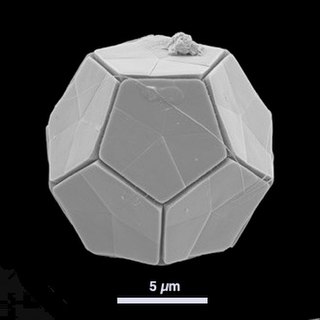Top Qs
Timeline
Chat
Perspective
Braarudosphaera bigelowii
Dodecahedron shaped coccolithophore From Wikipedia, the free encyclopedia
Remove ads
Braarudosphaera bigelowii is a coastal coccolithophore in the fossil record going back 100 million years to the Late Cretaceous.
Remove ads
Coccolithophore
The family Braarudosphaeraceae consist of single-celled coastal phytoplanktonic algae with calcareous scales with five-fold symmetry, called pentaliths. With 12 sides, it has a regular dodecahedral structure, approximately 10 micrometers across.[2][3]

Remove ads
Nitroplast and Endosymbiosis
Summarize
Perspective

Braarudosphaera bigelowii has 2 organelles originated from cyanobacterial endosymbosis. One is it's chloroplast, which originated from the secondary endosymbiosis, other eukaryote with chloroplast incorporate into it's ancestor. The other is nitroplast, which is the other independently primary endosymbiosis event (like chromatophore of Paulinella).
The ancestor of nitroplast was different from those of chloroplast. Both of them were able to photosynthesis. However, this function was reduced in Braarudosphaera bigelowii and became organell for nitogen fixation.
The nitroplast originated some 100 million years ago from a cyanobacterial endosymbiont called UCYN-A2, which allows B. bigelowii to fix nitrogen and convert it into compounds useful for cell growth.[4][5][6]This endosymbiosis event is much later than those of chloroplast of Archeaplastida, so many genes still preserve in host nucleus.
The number of chloroplast and nitroplast is fixed, so their devision should synchronize with cell devision to ensure that their offsprings can get correct number. This specie have 2 cloroplasts (secondary endosymbiosis) and one nitroplast, the order of replication of them is: mitochondria, nitroplast, nuceulus, than chloroplasts.
This phenomenon is previously known from diatoms in the family Rhopalodiaceae, where a nitrogen fixing and non-photosynthetic cyanobacterial endosymbiont, a diazoplast, provides the photosynthetic host cell with nitrogen.[7][8]
Remove ads
Name
The genus name Braarudosphaera is in honour of Norwegian botanist Trygve Braarud (1903–1985). He specialized in marine biology, and was affiliated with the University of Oslo.[9]
Metabolism, cell structure, and life cycle
The nitroplast have reduced their ancestral genes for photosynthesis, so it needs products from chloroplasts to support them. Such dependence on chloroplasts of nitroplast explain why the N2 fixation should undergo in daytime.
However, the coordination of photosynthesis and nitrogen fixing might cause some problems. The O2 from photosynthesis might inhibit the activity of nitrogenase, the enzyme for N2 fixing.
The N2 fixation is an energy-consuming process. This might be why the nitroplast is surrounded by mitochondria. The analogous structure is also observed in other cells that need tremendous energy, like vertebrate neurons.
Scientists infer that the cell division might also be related to the high energy demand. As observation, the cell division only happens in night time, when the photosynthesis and nitrogen fixing pause. As experiments, the LAC data (Linear Absorption Coefficient, index of molecular density) is low in mitochondria and nitroplasts at the time of their fission, which mean low providing of energy, and so the efficiency of N2 fixing. So the cell division and N2 fixing should stagger.[10]
Remove ads
Genome evolution
Summarize
Perspective
As other endosymbiotic organelles, nitroplast genome lost many genes and many essential biosynthetic pathways of them should be supported by the proteins produced in the nucleus.
After analyzing the genome and proteome in the nitroplast, scientists found that three types of proteins coexist in nitoplast, UCYN-1 encoded proteins, B. bigelowii encoded proteins (nucleus encoded), and the proteins encoded by both (“redundancies”).
Each B. bigelowii encoded proteins contain a special sequence name uTP (UCYN transition peptide), an extension at 3’ end of functional regions, which make them much longer than orthologous proteins found in other species. The uTP sequences assist the transition of proteins from nucleus to nitroplast. Actually, some B. bigelowii encoded proteins were not detected in nitroplast, but the existence of uTP sequence suggested that they might be transported into nitroplast.
Some proteins, like PyrC in the pyrimidine biosynthesis pathway, are produced in both nucleus and nitroplast. The scientists said that such redundancies might be the key reason why UCYN-1 lost genes faster than chromatophore in Paullina, whose endosymbiosis event happened in similar time.[10]
Remove ads
References
External links
Wikiwand - on
Seamless Wikipedia browsing. On steroids.
Remove ads

